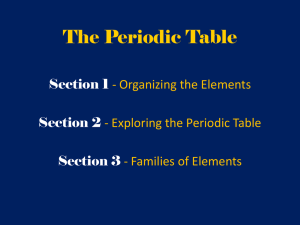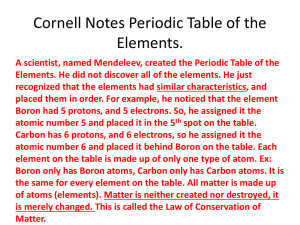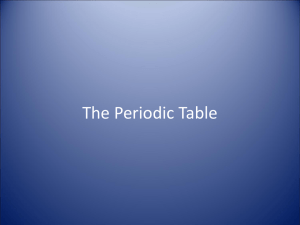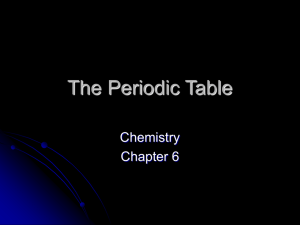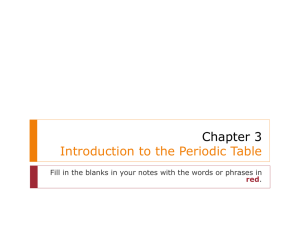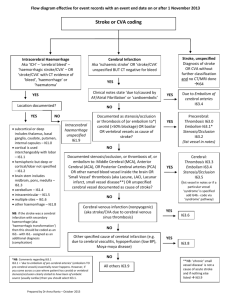DOC Chapter 6 Study Guide
advertisement
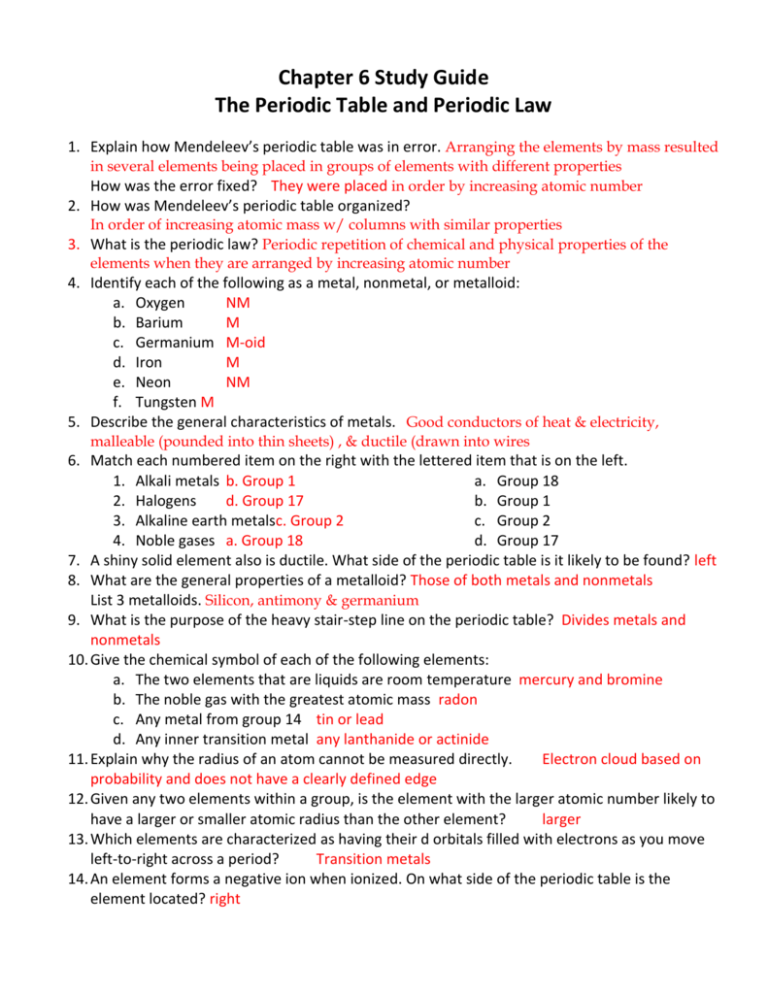
Chapter 6 Study Guide The Periodic Table and Periodic Law 1. Explain how Mendeleev’s periodic table was in error. Arranging the elements by mass resulted in several elements being placed in groups of elements with different properties How was the error fixed? They were placed in order by increasing atomic number 2. How was Mendeleev’s periodic table organized? In order of increasing atomic mass w/ columns with similar properties 3. What is the periodic law? Periodic repetition of chemical and physical properties of the elements when they are arranged by increasing atomic number 4. Identify each of the following as a metal, nonmetal, or metalloid: a. Oxygen NM b. Barium M c. Germanium M-oid d. Iron M e. Neon NM f. Tungsten M 5. Describe the general characteristics of metals. Good conductors of heat & electricity, malleable (pounded into thin sheets) , & ductile (drawn into wires 6. Match each numbered item on the right with the lettered item that is on the left. 1. Alkali metals b. Group 1 a. Group 18 2. Halogens d. Group 17 b. Group 1 3. Alkaline earth metalsc. Group 2 c. Group 2 4. Noble gases a. Group 18 d. Group 17 7. A shiny solid element also is ductile. What side of the periodic table is it likely to be found? left 8. What are the general properties of a metalloid? Those of both metals and nonmetals List 3 metalloids. Silicon, antimony & germanium 9. What is the purpose of the heavy stair-step line on the periodic table? Divides metals and nonmetals 10. Give the chemical symbol of each of the following elements: a. The two elements that are liquids are room temperature mercury and bromine b. The noble gas with the greatest atomic mass radon c. Any metal from group 14 tin or lead d. Any inner transition metal any lanthanide or actinide 11. Explain why the radius of an atom cannot be measured directly. Electron cloud based on probability and does not have a clearly defined edge 12. Given any two elements within a group, is the element with the larger atomic number likely to have a larger or smaller atomic radius than the other element? larger 13. Which elements are characterized as having their d orbitals filled with electrons as you move left-to-right across a period? Transition metals 14. An element forms a negative ion when ionized. On what side of the periodic table is the element located? right 15. Of the elements magnesium, calcium, and barium, which forms the ion with the largest radius? Ba The smallest? Mg What periodic trend explains this? Ionic radius increases down a group 16. What is ionization energy? The energy required to remove an electron from a gaseous atom 17. Explain why each successive ionization of an electron requires a greater amount of energy? The increase nuclear charge of each successive element produces an increased hold on the valence electrons 18. Which group has the highest ionization energies? 17 19. Define an ion. Atom that has loss or gained 1 or more electrons and has a charge 20. Explain why atomic radii decrease as you move left-to-right across a period. Caused by the increasing positive charge in the nucleus & principle energy level within periods remains the same 21. Which element in each pair has the larger ionization energy? a. Li, N b. Kr, Ne c. Cs, Li 22. Explain the octet rule. Atoms tend to gain, lose, or share electrons in order to acquire a full set of eight valence electrons 23. How many valence electrons do elements in each of the following groups have? a. Group 1 1 b. Group 18 8 c. Group 13 3 + 24. Na and Mg2+ ions each have ten electrons surrounding their nuclei. Which ion would you expect to have the larger radius? Na+ Why? the size of the positive ions gradually decreases 25. Which element in each pair is more electronegative? a. K, As b. N, Sb c. Sr, Be 26. An element is a brittle solid that does not conduct electricity well. Is the element a metal, nonmetal, or metalloid? 27. Arrange the elements oxygen, sulfur, tellurium, and selenium in order of increasing atomic radii. O, S, Se, Te Is your order an example of a group trend or a period trend? Group trend ALSO NEED TO KNOW: 28. What is a group or family? columns 29. What is a period? rows st 30. Who created the 1 periodic table? Mendeleev How was it arranged? By increasing atomic masses Who re-arranged it? Moseley How was it re-arranged? By increasing atomc #s 31. Names of the groups of elements for Group 1 (alkali metals), 2 (alkaline earth metals), 312 (transition metals), 17 ( halogens), and 18 (noble gases). 32. Where are the most reactive elements located? Groups 1 and 17 33. Where are the most unreactive elements located? Group 18 34. Characteristics of metals and non-metals. See Guided Reading Questions (GRQ) 35. What is ionization energy? See GRQ 36. What is electronegativity? See GRQ 37. What does the term periodic mean? See GRQ 38. Where is the d-block located? Transition metals What types of elements are in the dblock? Metals 39. Periodic trends in atomic radii and ionic radii. See GRQ 40. Periodic trends in ionization energy and electronegativity. See GRQ 41. How many electrons does it take for an element to have a “full” outer shell? 8 42. What is the law of octaves? See GRQ 43. What is the octet rule? See GRQ 44. What is and where are the representative elements? Elements in groups 1, 2, 13-18 45. What is an ion? See GRQ 46. What is and where are the transition elements? See # 38


